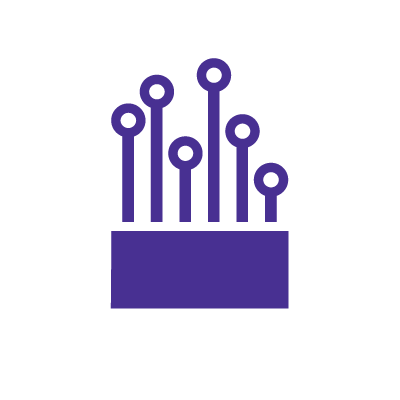Fixed wireless access vs. mobile broadband

If you’re deciding between fixed wireless access (FWA) or mobile broadband, you might be wondering which one is better. As with most internet services, it depends on your needs. However, there are some differences between the two.
For example, fixed wireless access provides a more reliable service at a fixed location than mobile broadband, while mobile broadband offers more locational flexibility.
In this article, we’ll explain in-depth the differences between fixed wireless access and mobile broadband.
The FWA technology gap
You deserve better internet
Fixed Wireless Access (FWA) uses radio waves which are impacted by obstacles like buildings and trees, resulting in reduced reliability.

What is fixed wireless internet?
Fixed wireless access, also referred to as 5G home internet, is a type of broadband internet service that uses radio signals to establish a connection between a fixed location, such as a home or business, and a communication tower.
Unlike mobile wireless services that use cellular networks to provide internet access on-the-go, fixed wireless is designed for stationary use.
How does fixed wireless internet work?
Fixed wireless internet works by establishing a wireless connection between a fixed location, such as a home or business, and a communication tower or base station.
Let’s take a look at how fixed wireless internet works.
Wired backbone connection
Most fixed wireless access providers are powered by fiber or cable infrastructure to bring internet to their base station. These connections are sent to their base station and broadcast over the base station’s communication tower to deliver wireless broadband into the home.
Subscriber equipment installation
For fixed wireless access, most fixed wireless access (FWA) providers offer equipment such as receivers. However, in some cases, wireless radios or antennas must be installed on the roof or in a high location.
Radio signal transmission
Once the equipment is installed, the receiver is aimed at the FWA provider’s base station in order to establish a connection. After a connection is established, the base station broadcasts a high-frequency radio signal and the equipment receives it.
Data transmission and reception
When the equipment begins to transmit signals, the receiver can be connected to a router to provide internet connectivity to various devices within the home or business.
Routing and internet access
Once connected and transmitting from the receiver to the router, users are able to access the internet through their router which decodes the communication tower’s signals and transmits them into accessible WiFi.
Key characteristics and considerations
When using fixed wireless access, there are a few key considerations to keep in mind. We’ll review some of the most common below.
Line-of-sight
In most cases, fixed wireless access points need a clear line-of-sight to the fixed wireless transmitter in order to deliver the best possible connection. Be sure your line-of-sight is free of any obstructions, such as walls, trees or other buildings and homes.
Frequency bands
Fixed wireless access uses frequency bands in order to transmit data. These bands are typically based on pre-existing frequencies, such as 3G, 4G or 5G bands. Within these bands, the frequencies 3.5GHz, 28GHz, 37GHz and 39GHz are typically used. By using existing infrastructure, fixed wireless networks can more reliably deliver internet into the home.
Speed and capacity
When not congested, fixed wireless access can reach average speeds of 200 Mbps. If your network is overloaded or crowded with multiple users and devices, you can expect the internet to slow down as providers adjust for peak hours and fair use.
Coverage area
Depending on how the network is configured, and whether you live in a rural or urban area, fixed wireless access providers are able to cover a range of at least one-third of a mile. For a potential customer, they would need to reside within that coverage area in order to benefit from their fixed wireless access coverage.
Check for service
Get internet service that delights
Astound is ranked among the best for overall satisfaction*. When it comes to download speed and quality, Astound more than delivers.

What’s the difference between fixed wireless and mobile wireless?
While fixed wireless and mobile wireless are both forms of wireless communications, they both serve different purposes and have distinct characteristics. Here are the key differences between fixed wireless and mobile wireless:
1. Purpose and Mobility
- Fixed wireless is great for people who are in a set location and need location-specific internet access. Once you leave the location where you’ve set up your fixed wireless access, you’ll lose your internet connection.
- Unlike fixed wireless or WiFi, mobile wireless is great for users on-the-go, or those who may need internet access to travel with them. As long as you stay out of areas with weak signal connectivity, you can take your mobile device and your internet with you.
2. Infrastructure
- Fixed wireless infrastructure is static and mounted to your home or business. Typically this infrastructure looks like a panel, or a set of panels, which interpret the signals broadcast from the cell tower.
- Mobile wireless receivers are built into many modern mobile broadband devices and run on 4G, LTE and 5G data. These devices may be standalone routers, or phones themselves. Depending on your location, these devices connect to the nearest cell tower and deliver mobile broadband to your device.
3. Speed and Capacity
- Be aware that fixed wireless access can be susceptible to some of the same issues as 5G home internet. This includes peak hours, throttling and slowdowns.
- Average mobile broadband speeds in the United States start at a minimum of 100 Mbps. Additionally, If you’re not a heavy on-the-go internet user, some mobile wireless plans offer the option of paying per Gigabyte of data. If you’re worried about your mobile data usage, consider an unlimited option to make the most of your plan.
4. Uses
- Fixed wireless is ideal for residential and business locations, especially in areas where laying traditional cable infrastructure is challenging or expensive. It’s commonly used in rural and underserved areas.
- Mobile wireless is suited for individuals who need internet access on the go. It is widely utilized for smartphones, tablets and other portable devices.
Fiber-powered internet
Why Fiber Internet works better
Astound’s fiber-powered internet provides consistent speeds throughout the day versus 5G Home Internet which is prone to intermittency.

Is it worth it to get fixed wireless over fiber or cable internet?
The decision to choose fixed wireless internet over fiber or cable largely depends on your specific needs, location and available options. Here’s a breakdown of factors to consider:
Usage Requirements: If you need a lot of bandwidth, work from home, game or have multiple users streaming simultaneously, a wired internet connection will be the best choice. If you’re only a moderate internet user and are in an area with no fiber infrastructure, fixed wireless access might be your only choice.
Cost: In some cases, the cost of installing fiber may be more expensive than the cost of installing fixed wireless access points. However, the cost of fiber is largely handled by ISPs wanting to break into new markets, not the consumer. For around 200 Mbps on fixed wireless access, a household can spend up to $1,800 a year, depending on availability.
Check the current cost of fiber-powered 1 Gig internet.
Reliability and Consistency: Wired connections have significant benefits over fixed wireless access in terms of speed, reliability and multi-device capacity. Fiber internet and infrastructure is established and isn’t prone to the same obstructions as fixed wireless access.
Geographic Location: If you’re in a rural or remote area where cable or wired connections are not available, fixed wireless might be your best option for high-speed internet.
Mobility Needs: Both fixed wireless access and fiber or cable internet are set in one location. If you need reliable internet access at home and on-the-go, it’s best to bundle your plan into one.
Network Speeds and Coverage: Fixed wireless access has a limited range, and clocks in at about 200 Mbps. With fiber, speeds of up to 1 Gig and even 5 Gig are available in some areas.
Build your plan
Your perfect plan is just a click away
Get the speeds, WiFi, mobile and TV plans you need all at an affordable price. Bundle your services with Astound and see how much you can save.

Fixed wireless internet is one of several technologies used to deliver internet access, offering an alternative to traditional wired connections – in certain cases. Fixed wireless access is tailored for stationary locations, in rural areas or areas with limited fiber infrastructure.
Mobile wireless, on the other hand, is designed for users who need internet connection while on-the-go. Mobile wireless can be accessed through mobile data plans, which can be connected to either mobile routers or smartphones.
However, the decision depends on your individual needs. Consider your internet usage habits, reliability, and available options for your location. If you’re curious about fixed wireless internet, it’s worth consulting local ISPs to discuss the current fixed wireless plans they offer, and how they compare with their mobile broadband offerings.
*Internet speeds may vary & are not guaranteed. Certain equipment may be required to reach advertised speeds. DOCSIS 3.1 modem with 2.5GE physical LAN port is required for 1 Gigabit speeds and higher. See astound.com/yourspeed for why speeds may vary. To view Astound’s FCC Network Management Disclosure see astound.com/policies-disclaimers. Limited time offer, subject to change without notice. Advertised promotional price valid for duration of the stated promotional period from time of service activation. Regular rates apply after promotional period ends. Equipment not included and is extra. Modem required for Internet service. Enhanced Wi-Fi or Whole Home Wi-Fi (eero) not included and is add’l. Offer includes a monthly discount for enrollment in both automatic payments (autopay) & paperless billing (e-bill). Discount of $10 applies with automated bank account deduction or a discount of $5 applies with automated credit/debit card payment. Valid email address required. Must complete enrollment in autopay and e-bill within 30-days of placing the order. Without enrollment, the discount does not apply. Discount appears on bill within 3 bill cycles after enrolling. If either autopay or e-bill is canceled, services are changed, or the account is not in good standing, then the monthly discount will be discontinued. Offer valid only for new residential Astound customers or previous customers with an account in good standing who have not had Astound service within the last 60 days. Any add’l services, equipment, premium channels & other tiers of service are subject to an add’l charge & regular increases. A one-time activation fee of $14.99 (in addition to any installation fees) will be charged & is subject to change. Add’l fees apply for taxes & surcharges, and are subject to change. WA RESIDENTS: unless otherwise specified, price does not include a 2% Regulatory Administration Fee. For details about taxes, fees & surcharges visit astound.com/fees. No early termination fees apply in the event service is terminated in advance of the promotional end date. Customer is responsible for any accrued service charges in the event service is canceled. Subject to credit check. Not all services & speeds are available in all areas. A multi-product discount may be available to qualifying addresses with a subscription to mobile, TV, and 600 Mbps Internet or higher. Discounts will be reflected in your order cart at time of purchase, if available. Other restrictions may apply. All services are governed by the Astound Customer Terms & Conditions that can be found at astound.com/policies-disclaimers. © 2025 Radiate HoldCo, LLC d/b/a Astound Broadband. All rights reserved.
While we have made every attempt to ensure that the information contained in this site has been obtained from reliable sources, Astound is not responsible for any errors or omissions, or for the results obtained from the use of this information. All information in this site is provided “as is”, with no guarantee of completeness, accuracy, timeliness and without warranty of any kind, express or implied, including, but not limited to warranties of performance, merchantability and fitness for a particular purpose. Certain links in this site connect to other websites maintained by third parties over whom Astound has no control. Astound makes no representations as to the accuracy or any other aspect of information contained in other websites.
eero Plus is available for an additional $9.99/month and requires subscription to whole home WiFi powered by eero.

















